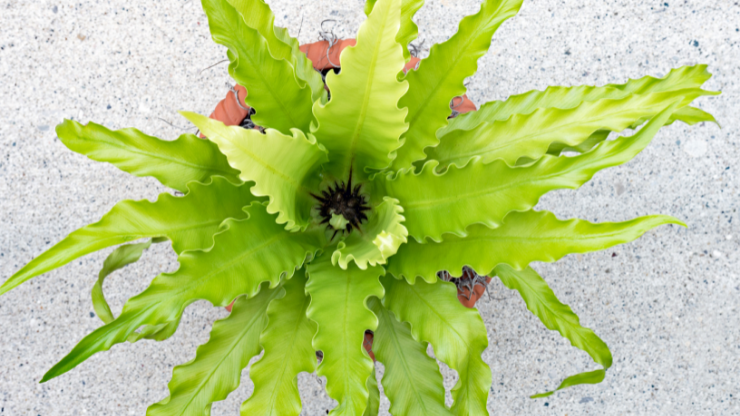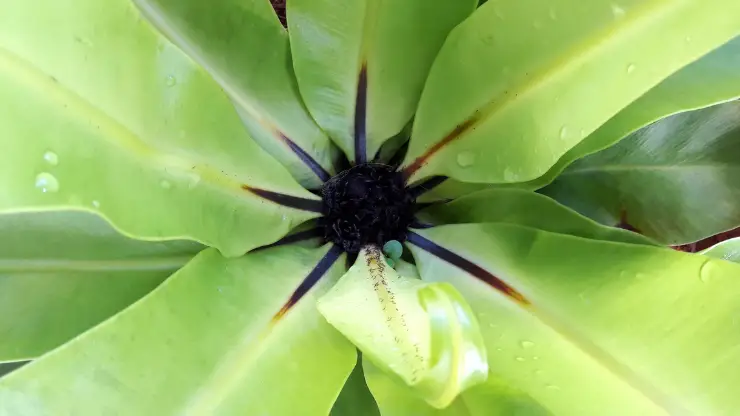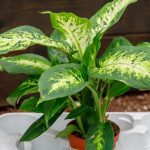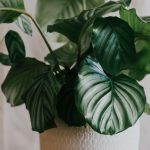
Japanese Asplenium nidus fern (also known as bird’s nest fern or crispy wave fern) is a beautiful true fern – although it doesn’t really look like one. It sprouts long, strappy, bright green leaves directly from an underground rhizome – and they don’t look like traditional fern leaves at all.
Prized for this unique foliage, they reach up to two feet tall indoors and make an impressive display in any room. They’re also much easier to care for than other ferns. In this post, I’ll show you how to care for Japanese Asplenium nidus fern to keep it thriving in your home.
How to Care for Japanese Asplenium Nidus Fern
I consider this fern moderately easy to grow. It does require high humidity and special care should be taken when watering. But if you get those two things right, it will grow beautifully. When it’s happy, new fronds unfurl from the plant’s center. Here are the basics of care:
- WATER: Moderate, when top 1/2 inch of soil dries
- HUMIDITY: High, mist regularly
- FEEDING: Once monthly with diluted fertilizer
- LIGHT: Medium (east- or north-facing window)
- TEMPERATURE: 60 – 75 degrees F (15 – 24 degrees C)
- SAFETY: Non-toxic to pets and people
- DIFFICULTY: Moderate
This is a basic run-down of care guidelines, but keep reading for more in-depth information on caring for Asplenium nidus.
Water
Water when the top 1/2 inch of potting soil becomes dry. (Insert your finger into the soil to test the moisture level.) Japanese Asplenium nidus fern needs lots of water, but it cannot tolerate soggy soil or standing water. Be careful not to over-water and to drain off any standing water after watering.
Water around the edge of the pot, and avoid pouring water directly in the center of the “nest.” This can rot the plant and cause its leaves to fall off.
In the wild, this fern grows as an epiphyte on the sides of trees. It grows at an angle, so water never sits too long in the middle of the “nest.” As a houseplant, it grows standing straight up in a container, and excess water may not drain away completely.

Humidity
Japanese Asplenium nidus fern needs high humidity levels. Raise humidity by placing it on a shallow tray filled with pebbles and water (also known as a humidity tray), and mist daily with a spray bottle of lukewarm water set to the “mist” setting.
If you live in a dry climate or have a centrally heated home, it’s a good idea to place a high-quality humidifier in the same room as the fern. See my favorite houseplant humidifier review (the one I’m using right now), or click here to view it directly on Amazon.
Fertilizer
In spring through fall, feed Japanese Asplenium nidus fern once a month using a balanced houseplant fertilizer diluted to half strength. In winter, continue monthly feedings but dilute fertilizer to quarter strength.
My favorite fertilizer for foliage plants and ferns is JR Peters Houseplant Special. You can read about why I love this brand of fertilizer so much on this page (and check out the Amazon reviews to see I’m not alone in my love for this stuff).
Light
Place this fern in medium bright light. The ideal location is in an east-facing window, but it will also grow in the lower light of a north-facing window. Alternatively, you can place it a few feet away from a west-facing window or several feet away from a south-facing window.
Bright fluorescent light also works, and you can grow this fern easily under artificial lights. Although it will tolerate some shade and low light conditions, it cannot tolerate direct sun. This will burn the fern’s delicate fronds.
Temperature
Ideal temperature for Japanese Asplenium nidus fern is between 60 and 75 degrees F (15 and 24 degrees C). It can tolerate temperatures as low as 55 degrees F (13 degrees C), but only for short periods of time. This fern prefers cool to average temperatures, and doesn’t tolerate the cold.

Potting
The best potting mix for Japanese Asplenium nidus fern is a half-and-half mixture of peat moss and potting soil. Use any high-quality potting soil formulated for houseplants. My favorite is this one by Happy Frog because it contains mycorrhizal fungi and beneficial soil microbes.
When your fern outgrows its container, move to a pot 2 inches (5 centimeters) in diameter larger than the current one. Choose a small but heavy pot to prevent this top-heavy fern from toppling over. I like to used glazed ceramic, as they are much heavier. Re-pot every two years in spring.
Propagation
Japanese Asplenium nidus fern cannot be divided and must be raised from spores. This is difficult for the average houseplant enthusiast. In my experience, if you want another plant, you’ll be better off just purchasing a second one.
Maintenance
This fern is pretty low-maintenance, but you will have to clip off old outer fronds when they turn brown with age (this is normal). This keeps your plant fresh looking, and soon shiny new green leaves will replace the old, dead ones.
If the broad leaves collect dust (which they will eventually), rinse them with a light spray of water and/or wipe them with a clean, damp cloth. See my post on how to clean your houseplant’s leaves for more guidance on this topic.
Troubleshooting
BROWN LEAVES: If your fern’s leaves are turning brown it may be natural aging. It’s normal for the old, outer fronds to turn brown and die off. Simply snip them off as described above and new green leaves will soon take their place.
Japanese Asplenium nidus fern is also sensitive to chemicals such as insecticides and leaf-polishing products, which can cause a phytotoxic reaction that burns the foliage. Never use leaf-polishers on this plant and avoid any chemical sprays.

Related Questions
Following are some commonly asked questions related to Japanese Asplenium nidus fern (and my brief answers to them).
How do you care for a Japanese Asplenium Nidus Fern?
Place in bright, indirect light such as a north- or east-facing window. Keep temperatures cool to average, feed monthly with a fertilizer diluted to half strength in spring through fall (quarter strength in winter), water when the top 1/2 inch of soil dries out, and keep humidity high.
Why is my Japanese Asplenium Nidus Fern Dying?
Too much light can quickly kill this fern. Make sure it receives only bright, indirect light and never full sun. If temperatures drop too low, this can also cause your fern to die. But the most common culprit is low humidity and/or not watering often enough. Water any time the top 1/2 inch of soil dries out, and keep humidity high at all times.
Should ferns be in direct sunlight?
No, never put true ferns in direct sunlight. They are native to forest floors and need bright, indirect light at most. Some ferns – like the Asplenium nidus – can even tolerate low light conditions. As houseplants, place ferns in east-facing windows for the best results.
Where to Buy Japanese Asplenium Nidus Fern
This plant can be difficult to find locally. I recommend calling around and asking at your local plant nurseries. If you live in a more tropical climate, you may get lucky and find one at a big box store with garden department (like Walmart or Lowe’s).
If you can’t find one locally, but you really want to grow this beautiful fern, I recommend checking the listings on Etsy. I always buy my exotic and hard-to-find houseplants on Etsy. I like supporting small growers and they tend to have much better quality plants than large online nurseries.
Click here to see the current Etsy listing for Japanese Asplnium Nidus fern. You may have some luck searching for it by its more common name – Bird’s Nest Fern – as well. Good luck and happy growing!




